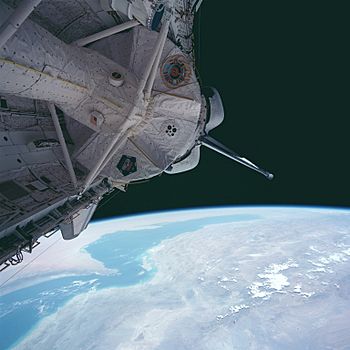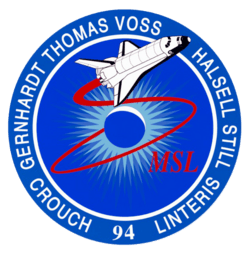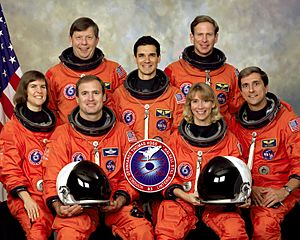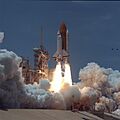STS-94 facts for kids
STS-94 was a special mission of the United States Space Shuttle Columbia. It launched on July 1, 1997. This mission was all about studying how things behave in space, especially in very low gravity. Scientists call this "microgravity."
The main goal of STS-94 was to use a special laboratory called the Microgravity Science Laboratory (MSL). This lab was inside a European Spacelab module, which fit into the shuttle's cargo bay. The mission helped scientists learn more about materials and how they act when gravity isn't pulling on them much.

Spacelab Module LM1 in Columbia's payload bay, serving as the Microgravity Science Laboratory
|
|
| Mission type | Microgravity research |
|---|---|
| Operator | NASA |
| Mission duration | 15 days, 16 hours, 45 minutes, 29 seconds |
| Distance travelled | 10,000,000 kilometres (6,200,000 mi) |
| Spacecraft properties | |
| Spacecraft | Space Shuttle Columbia |
| Landing mass | 117,802 kilograms (259,709 lb) |
| Payload mass | 10,169 kilograms (22,419 lb) |
| Crew | |
| Crew size | 7 |
| Members |
|
| Start of mission | |
| Launch date | 1 July 1997, 18:02:02 UTC |
| Launch site | Kennedy LC-39A |
| End of mission | |
| Landing date | 17 July 1997, 10:47:29 UTC |
| Landing site | Kennedy SLF Runway 33 |
| Orbital parameters | |
| Reference system | Geocentric |
| Regime | Low Earth |
| Perigee | 296 kilometres (184 mi) |
| Apogee | 300 kilometres (190 mi) |
| Inclination | 28.45 degrees |
| Period | 90.5 minutes |
  Left to right – Front row: Voss, Halsell, Still, Thomas; Back row: Crouch, Linteris, Gernhardt |
|
Contents
Meet the Astronauts: STS-94 Crew
The STS-94 mission had a crew of seven astronauts. What made this crew special is that they were the exact same seven people who flew on the previous mission, STS-83. This was the only time in spaceflight history that a crew with more than one person flew two missions in a row!
| Position | Astronaut | |
|---|---|---|
| Commander | James D. Halsell Fourth spaceflight |
|
| Pilot | Susan L. Still Second and last spaceflight |
|
| Mission Specialist 1 | Janice E. Voss Fourth spaceflight |
|
| Mission Specialist 2 | Michael L. Gernhardt Third spaceflight |
|
| Mission Specialist 3 | Donald A. Thomas Fourth and last spaceflight |
|
| Payload Specialist 1 | Roger Crouch Second and last spaceflight |
|
| Payload Specialist 2 | Greg Linteris Second and last spaceflight |
|
| STS-94 was flown by the same crew that flew STS-83, the only time in the history of human spaceflight that two missions with more than one crewmember had exactly the same crew. | ||
Why STS-94 Was a Reflight Mission
STS-94 was actually a repeat of the STS-83 mission. The first attempt, STS-83, launched on April 4, 1997. It was supposed to last for about 15 days. However, a problem came up with one of the shuttle's fuel cells. Fuel cells create electricity for the spacecraft. Because of this issue, the mission had to end early. Columbia landed after only about four days in space.
Because the first mission was cut short, the important science experiments couldn't be finished. So, NASA decided to fly the exact same mission again with the same crew and equipment. This second flight became STS-94.
Exploring Microgravity: The MSL Lab
The main part of both STS-83 and STS-94 was the Microgravity Science Laboratory (MSL). This special lab was built inside a European Spacelab module. It was designed to study how different materials and processes behave when there's very little gravity.
Scientists wanted to understand things like how metals melt and mix, how flames burn, and how liquids behave in space. These studies help us learn more about basic science and can also lead to new materials and technologies here on Earth.
Experiments in the Microgravity Science Lab
The MSL had many different experiments. They were grouped into several main facilities, which are like special labs within the larger Spacelab module.
Studying Materials with Heat
One important facility was the Large Isothermal Furnace. This furnace was used to heat materials to very high temperatures. Scientists studied how different metals and alloys (mixtures of metals) spread and mix when they are melted in microgravity. This helps them understand how to make better materials.
Understanding Fire in Space
Another facility focused on Combustion, which is how things burn. The Droplet Combustion Experiment (DCE) looked at how single drops of fuel burn in space. Flames in microgravity look very different from flames on Earth because there's no gravity to pull hot air up. Studying this helps us understand fire safety in space and how combustion works.
Working with Liquids and Drops
The Middeck Glovebox (MGBX) was a sealed area where astronauts could safely do experiments with liquids and drops. They studied how drops behave without gravity, like how they move and combine. This research is important for managing fluids in spacecraft.
Measuring Tiny Forces
Even though it's called "microgravity," there are still tiny forces that can affect experiments. Special tools like the Space Acceleration Measurement System (SAMS) and the Microgravity Measurement Assembly (MMA) were used to measure these very small forces. This helped scientists make sure their experiments were accurate.
Mission Success
The STS-94 mission was a great success. It allowed scientists to complete the experiments that were cut short on STS-83. The crew spent over 15 days in orbit, collecting valuable data on microgravity science. This mission showed how important it is to be able to re-fly a mission if something goes wrong, especially when doing complex scientific research in space.
Images for kids







